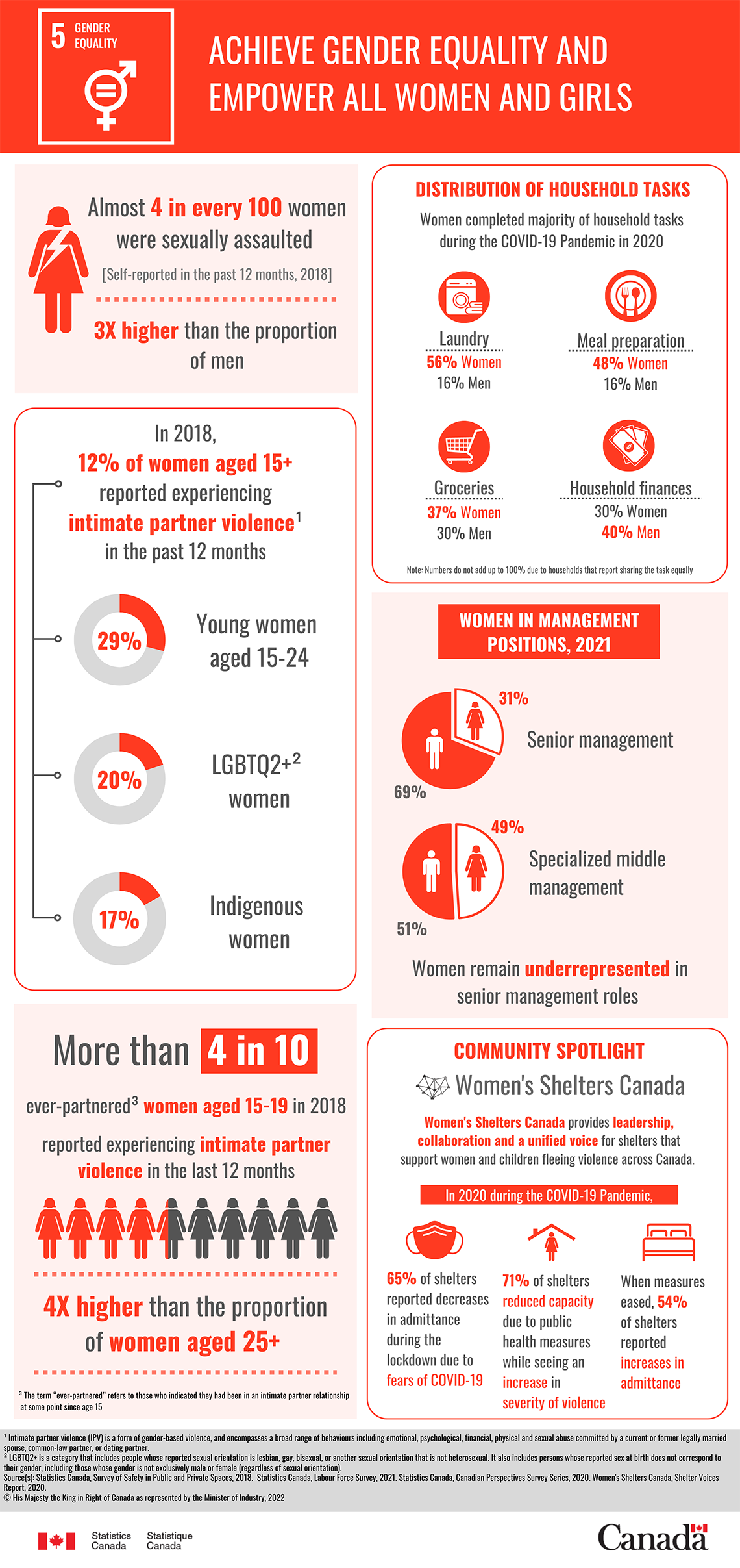Agenda 2030 Sustainable Development Goals Report, 2022
Goal 5, Gender Equality

Description: Sustainable Development Goals: Goal 5, Gender Equality
Achieving gender equality and empowering all women and girls
Self-reported sexual assault and intimate partner violence in the previous 12 months, 2018
Almost 4 in every 100 women have been sexually assaulted. This is three times higher than the proportion of men.
In 2018, 12% of women aged 15 and older reported experiencing intimate partner violenceNote 1 in the previous 12 months.
| Selected characteristic | Percentage that reported experiencing intimate partner violence in previous 12 months |
|---|---|
| Women aged 15 to 24 years | 29% |
| LGBTQ2+Note 2 women | 20% |
| Indigenous women | 17% |
Intimate partner violence among young women aged 15 to 24
In 2018, more than 4 in 10 ever-partneredNote 3 women aged 15 to 19 reported experiencing intimate partner violence in the previous 12 months.
| Age group | Percentage that reported experiencing intimate partner violence |
|---|---|
| 15 to 19 years | 43% |
| 20 to 24 years | 24% |
| 25 years and older | 10% |
The proportion of women who reported intimate partner violence was four times higher among women aged 15 to 19 than among than women 25 years and older.
Note: The term “ever-partnered” refers to those who indicated that they had been in an intimate partner relationship at some point since age 15.
Note: Intimate partner violence is a form of gender-based violence and encompasses a broad range of behaviours, including emotional, financial, physical and sexual abuse committed by a current or former legally married spouse, common-law partner, or dating partner.
Distribution of household tasks
Women completed the majority of household tasks during the COVID-19 pandemic in 2020
| Household task | Tasks done mostly by women | Tasks done mostly by men |
|---|---|---|
| Laundry | 56% | 16% |
| Meal preparation | 48% | 16% |
| Groceries | 37% | 30% |
| Household finances | 30% | 40% |
Note: Numbers do not add up to 100% due to households that reported sharing the task equally.
Women and management positions in 2021
Women remain underrepresented in senior management roles.
| National Occupation Classification (NOC) | Proportion of men | Proportion of women |
|---|---|---|
| Senior management occupations | 69% | 31% |
| Specialized middle management occupations | 51% | 49% |
Community spotlight: Women’s Shelters Canada
Women’s Shelters Canada provides leadership, collaboration and a unified voice for shelters that support women and children fleeing violence across Canada.
In 2020, during the pandemic, 65% of shelters reported decreases in admittance during the lockdown due to fears of COVID-19. Additionally, 71% of shelters reduced capacity in accordance with public health measures, but saw an increase in the severity of violence. When measures eased, 54% of shelters reported increases in admittance.
Sources: Statistics Canada, Survey of Safety in Public and Private Spaces, 2018, Labour Force Survey, 2021, Canadian Perspectives Survey Series, 2020; Women’s Shelters Canada, Shelter Voices Report, 2020.
- Date modified: